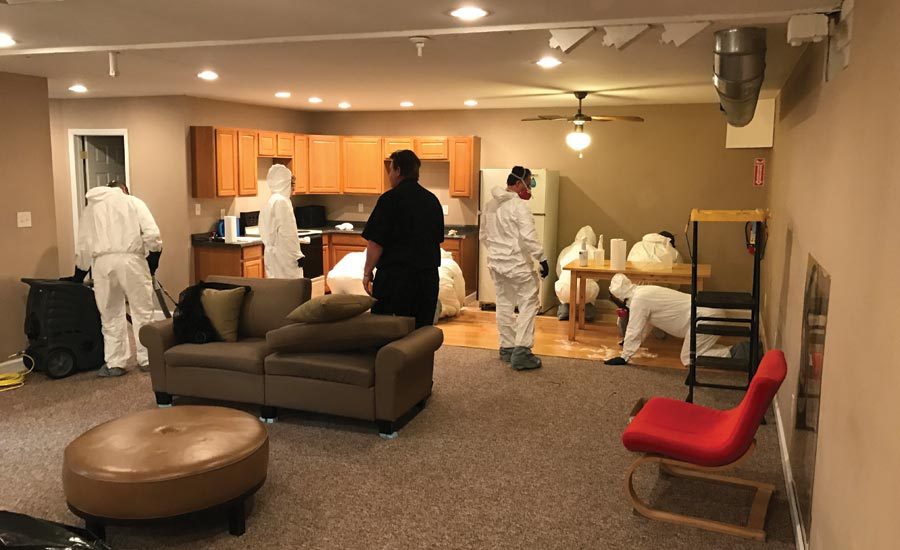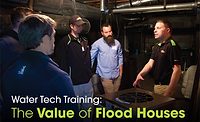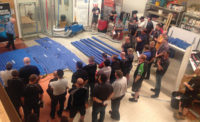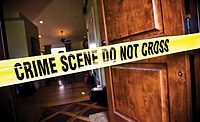Flood houses offer a unique way for restoration companies to train employees on drying methods and equipment before sending them out to a real water loss. There are many flood houses around the country – some that operate as independent businesses, and some that are run by manufacturers specifically so current customers and potential customers can give equipment a test drive before making a large purchase.
As the work of restoration companies expands into new arenas like crime scene cleanup and illicit drug lab remediation, some flood houses are making changes to offer training beyond drying science and techniques.
From Vacuums to Flooding to Crime Scenes
Schaper’s Flood House in Philadelphia, Penn., is in that mix trying to break out of the flood house norm. Current owner Eric Schaper is following in his grandfather’s entrepreneurial spirit. What started as a sewing machine and vacuum shop more than six decades ago is now a large cleaning and restoration supply house in Philly, complete with a full flood house inside.
“This year, we are holding 24 classes, two a month, covering many different industry certifications and workshops,” Eric explained. In all, he expects about 330 students to pass through from all around the country.
To date, Eric estimates there have been 60 to 70 floods inside the house that actually shares an outer wall and part of the roof with the actual structure of the warehouse building in which it sits. This means part of the home is truly exposed to the elements just like a normal house. There is also has an attic with every kind of duct work on the market today, and a crawl space.
“The house is built to Philadelphia code,” Eric said. “Basically what the IICRC mandates is it must be a non-conditioned space. It’s a true house, 100 percent. Sometimes, we are drying when it is 25 degrees outside and we use different equipment to heat up the materials and spaces. It is very different from training in climates that are only warm.”
Thinking outside the Box
While Schaper’s primarily works with the IICRC, in February, the company partnered with the Restoration Sciences Academy to host a forensic restoration course in the flood house. Eric knew some of the materials and contaminants (or mock contaminants) brought into the home could be quite a chore to remediate, but was anxious to branch out and offering a whole new training opportunity at the facility.
Thanks to the wide array of materials inside the facility, there is plenty of opportunity to learn remediation techniques, whether it’s blood borne pathogens, category 3 water, or otherwise. Students learn how to build containment for mold remediation or trauma cleanup. They learn how to create doors, different containment chambers, seal vents, and do pressure testing to make sure there is enough negative air going through the space. And, of course, they learn proper PPE protocols for different types of jobs they’ll face.
Some instructors are also teaching how to use the latest technology in thermal imaging cameras and sure-test circuit analyzers, which can tell crews how much power air movers or other equipment is using and if they are close to tripping a breaker. After all, you don’t want to set up equipment only to return in the morning to discover a breaker was tripped, and it had been off for hours.
Down the road, Eric hopes to keep expanding what people can learn at his facility and is tossing around the idea of adding a smoke house to learn fire and smoke damage restoration, and how to do a complete packout.
The Core: Instructors
Eric says flood houses are successful thanks to good instructors. He carefully selects some of the best instructors in the industry to run classes at the facility thanks to relationships he has built during his tenure in restoration.
“Our teachers have been in the industry for some time and know it well,” he said. “The industry is always changing and techniques, materials and technology evolving. We try to come at it and show everything that is out there and the proper way to do things.”
Flood houses are quite common in the restoration industry today, and there are several around the country. They remain an important training tool for contractors wanting their crews to be well-trained and certified in the work they do.











Report Abusive Comment